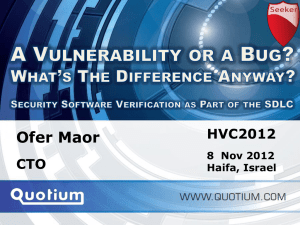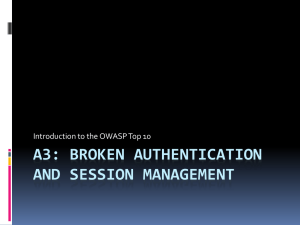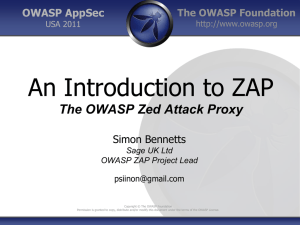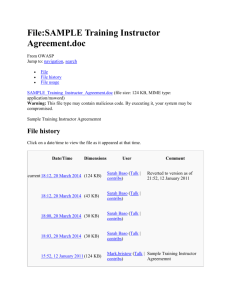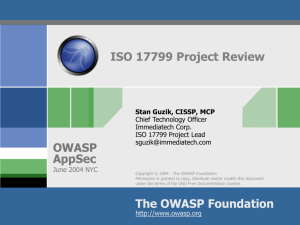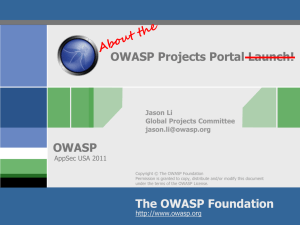Canike - OWASP AppSec DC 2005
advertisement
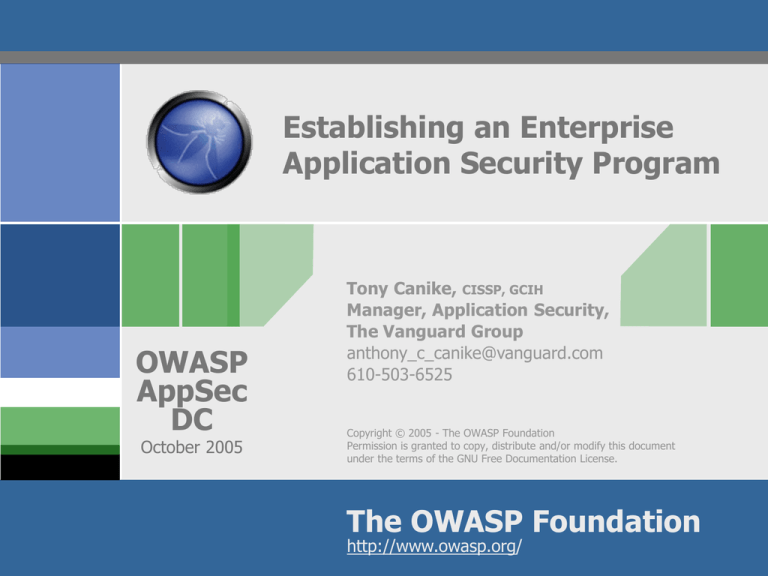
Establishing an Enterprise Application Security Program OWASP AppSec DC October 2005 Tony Canike, CISSP, GCIH Manager, Application Security, The Vanguard Group anthony_c_canike@vanguard.com 610-503-6525 Copyright © 2005 - The OWASP Foundation Permission is granted to copy, distribute and/or modify this document under the terms of the GNU Free Documentation License. The OWASP Foundation http://www.owasp.org/ What today’s talk is about What is an Application Security program? The need for an Application Security program in your organization Detailed look at the components of an Application Security program Roadmap to establish your own Application Security program This talk presumes the existence of network, server, physical, and organizational security efforts. Canike - OWASP AppSec DC 2005 2 Setting the Stage In my organization… Application Security is an IT function Information Security is a business function Close cooperation and some overlap Mix of purchased and in-house developed business applications Many business applications developed in-house Canike - OWASP AppSec DC 2005 3 What is an Application Security Program? Def. 1: An integrated approach to Application Security in your organization Not scattershot Not tools with shiny red buttons Def. 2: A corporate initiative to define, promote, assure, and measure the security of critical business applications. So what does that really mean… Canike - OWASP AppSec DC 2005 4 People, Process, and Technology all aligned to ensure secure business applications. People Policy Standards Awareness Training Roles Priority Expert Assistance Process SDLC App Inventory Standard Requirements Risk Management Risk Rating Reviews Governance Technology Standard Controls Input Validation Tools Canike - OWASP AppSec DC 2005 5 Application Security: Part of the Big Picture Conceptual Information Security Dashboard Business Applications Data Security Vendors & Partners Business Processes Computing Infrastructure Intrusion Detection Network & Telecom Infra Physical Security Compliance Business Continuity Incident Response Fraud Prevention Simplified example only. A complete dashboard could have 20-30 indicators. Canike - OWASP AppSec DC 2005 6 Benefits of an Application Security program Knowledge to… keep the C-suite informed communicate areas of opportunity develop high-level action plans assist the application development teams optimally allocate resources and funds protect client and corporate assets Canike - OWASP AppSec DC 2005 7 Why do you need an Application Security program? What are your big application security issues, anyway? Can you back up recommendations with data? Can you justify expenditures? Security is more then securing the network perimeter… …do you have data to support that? Your network security colleagues have numbers, you need numbers too. Use Data, Metrics, Numbers, Facts Data-driven decision making Really know what is working and what is not Motivate actions Suggestions for metrics collection throughout presentation Canike - OWASP AppSec DC 2005 8 Knowledge in multiple dimensions Training and Awareness Leading Indicator Are IT Staff trained and aware of security issues? Leading Indicator SDLC Maturity and Compliance Is security baked-in to your Software Development Life Cycle? Are you following your SDLC? Reference Architectures and Standard Controls Provided? Security Assessment Coverage of the Application Space Are you doing enough assessments? Frequently enough? Anything you don’t know you don’t know? Application Risks and Vulnerabilities Post Indicator When are security problems found? During Code? Test? Prod? Are you mitigating risks in a timely fashion? Canike - OWASP AppSec DC 2005 9 How much security do we need? Canike - OWASP AppSec DC 2005 10 Components of an Application Security program People Policy Standards Awareness Training Roles Priority Expert Assistance Process SDLC App Inventory Standard Requirements Risk Management Risk Rating Reviews Governance Technology Standard Controls Input Validation Tools Canike - OWASP AppSec DC 2005 11 People: Policies and Standards Information Security Policies IT Architecture Standards Reference application architectures (w/security) Standard security controls identified SDLC Defined Standard Application Security Requirements Use reviews to govern and enforce Dashboard Indicators, Metrics Canike - OWASP AppSec DC 2005 12 People: Awareness and Training Awareness of policies and standards Information Security Corporate intranet or newsletter articles Web-based training Training Security architects Managers Technical leads Developers Testers Etc… Dashboard Indicators, Metrics Canike - OWASP AppSec DC 2005 13 People: Define Specialized Roles Security Architects Understand standard application controls and how to implement them Directly supporting application development Setting enterprise-wide standard security architecture Application Security Assessment Team Small, quasi-independent team Assess architectures and test for vulnerabilities Access Management Team Business group grants access to business applications Keeper of the keys (literally and figuratively) Not developers, not users, not system admins Canike - OWASP AppSec DC 2005 14 People: Prioritize Security Time to market, business functionality, and cost all compete with security concerns. Executive attention One suggestion: IT VP’s present their security metrics/dashboard to an executive committee quarterly Report security vulnerabilities as defects Defect-elimination mentality already engrained? If so, leverage it. If not,… Canike - OWASP AppSec DC 2005 15 People: Expert Assistance Security experts are available to application development teams Security Architects Central team to maintain standard security controls Eval, purchase, development, support of technical controls Access management team Information Security Product Vendor resources Consultants as necessary Canike - OWASP AppSec DC 2005 16 Components of an Application Security Program People Policy Standards Awareness Training Roles Priority Expert Assistance Process SDLC App Inventory Standard Requirements Risk Management Risk Rating Reviews Governance Technology Standard Controls Input Validation Tools Canike - OWASP AppSec DC 2005 17 Process: Software Development Life Cycle Integrate security steps into your SDLC Will take a few iterations to mature. Baked-in, not bolted-on End-game penetration test is not sufficient Find security issues early Much easier, cheaper to fix Measure compliance Self-reporting Audit a sampling Voice of Practitioners Are the processes working? Dashboard Indicators, Metrics Canike - OWASP AppSec DC 2005 18 Process: Application Development Life Cycle Business Arch & Planning Requirements Application Categorization Security Requirements Analysis, Design & Implementation Access Control Input Validation Security Architecture Review Design & Code Review Unit & Integration Test Test Elevation System Test Categorize Define Requirements Build Controls Vulnerability Test Governance Review Verify Controls Governance Review Risk Management Pre-Elev Risk Review Track Security Metrics Track and Manage Defects and Risks Canike - OWASP AppSec DC 2005 19 Process: Inventory and Categorize your Applications List all your business applications, the business owner, and the IT owner (might be hard) Categorize applications w.r.t. criticality of security Potential Business Impact Quick Technical Assessment – surface area, complexity, data classification Ref. NIST 800-64 and FIPS 199 Use categorization to prioritize security attention and assessments. Assessments Performed? How recently? Dashboard Indicators, Metrics Canike - OWASP AppSec DC 2005 20 Process: Standard Security Requirements Define Security Requirements Standards for your business applications. Which controls are necessary When are they necessary (applicability) Why are they necessary (e.g. SEC, SOX, etc.) Easy to use reference for requirements teams Standard method to implement each control Provide reference on how to implement Requirements for requirements E.g. The need to specify functional business requirements for access control Canike - OWASP AppSec DC 2005 21 Process: Security Assessments of Applications Choose types of assessments that fit your organization. Security Architecture/Design Reviews Security Code Reviews Application Vulnerability Tests Risk Acceptance Review External Penetration Test of Production Applications White Box Philosophy – look inside the application Use all the advantages you have Past reviews, design documents, code, logs, interviews, etc. Attackers have advantages you don’t, don’t tie your hands. Part of your SDLC Define which reviews when, by whom, and how in your SDLC Don’t underestimate the amount of work necessary for communication, scheduling, report writing, logistics Canike - OWASP AppSec DC 2005 22 Security Architecture/Design Review Architecture/Design time assessment of an application and its security controls Component interface and connection driven Enumerate through the interfaces and connections considering threats, vulnerabilities, and risks STRIDE Identify non-standard, home-brewed or missing security controls Issue a report Identify vulnerabilities to mitigate or fix Identify issues for follow-up Canike - OWASP AppSec DC 2005 23 Security Code Review Focus on code relevant to security Utilize experts Consider consulting firms with specialized techniques. Specialized Tools Have a technique to wade through 5 million lines of code Define Scope and Purpose Project Manager: “since you are reviewing my code, I can skip all my code reviews, ok?” Not so fast… You are not reviewing the code for the application team – they are still on the hook for code quality. Canike - OWASP AppSec DC 2005 24 Application Vulnerability Test Hands-on testing of application around System Test time “Port 80” types of attacks Goal is to find most of the problems early and get them fixed. Not trying to prove a point, not playing capture-the-flag Use a small dedicated team supported by consultants Educate and collaborate with development teams Use all advantages you have – white box Logs, source code, business knowledge, prior assessments Define purpose – are you going to validate that the application meets all of its security requirements? Probably not. Make that clear up-front. Define scope – which components are being tested? Use the architecture diagram Canike - OWASP AppSec DC 2005 25 Process: Information Security Risk Management Document your risk rating process Common risk rating method and scale Consider business impact and likelihood/DREAD factors Rationale for a particular risk rating known and documented Common taxonomy Categorize and count – perhaps 10 categories Weed out false positives early – reduce noise Draft, Review, Revise Apply to all IT-owned InfoSec Risks from all sources Consultants, IT Security Assessments, InfoSec Assessments, Internal Audit (if possible), Corporate Risk Management, etc. Develop/Adapt process through consensus Calibrate! Canike - OWASP AppSec DC 2005 26 Example Job Aid – Likelihood Factors WHO? Mitigating Controls Attractive? Well Known? Skill Level HIGH L I K E L I H O O D LOW Public All Internet Direct Access Very Attractive CORP Inc Customers CORP Inc Unintentional Internal One Control IT Employees Two Controls No special skills Somewhat Attractive Proprietary Technical Very Technical System Admins Three or more Illustrative example only. Not Attractive Theoretical Canike - OWASP AppSec DC 2005 27 Process: Information Security Risk Management (cont.) Common Repository for tracking Assessments Risks/Vulnerabilities Mitigation Actions and Status Common report formats Differing formats from different assessment teams (internal, consultants, audit) confuses everyone Common summary reports Open risk counts, severity, category, owners, time-to-close, … Train management on how to read summary reports Dashboard Indicators, Metrics Canike - OWASP AppSec DC 2005 28 Process: Risk Review and Acceptance Review known security risks and mitigation status prior to production elevation. Business owners key participants Need to understand and accept (or not) outstanding risks prior to elevation No surprises… Dashboard Indicators, Metrics Canike - OWASP AppSec DC 2005 29 Process: Other tests and assessments…. Of course, utilize the gamut of security assessments, including Internet Penetration Tests Network and vulnerability scans Server security scans Up to you to define the boundary of “Application Security” for your organization. Cooperate, avoid fiefdoms Canike - OWASP AppSec DC 2005 30 Process: Governance Team Reviews IT-wide governance team of practitioners reviews summaries of security assessments and tests Were the risks rated properly? Was the assessment or test complete? Is the responsible individual taking responsibility and fixing the issues? What are the common themes and trends? What improvements to people-process-technology can be implemented? Canike - OWASP AppSec DC 2005 31 Components of an Application Security Program People Policy Standards Awareness Training Roles Priority Expert Assistance Process SDLC App Inventory Standard Requirements Risk Management Risk Rating Reviews Governance Technology Standard Controls Input Validation Tools Canike - OWASP AppSec DC 2005 32 Technology: Standard Controls Provide standard technical controls to your application development teams. Determine needs and prioritize Consider authentication, access control, certificate management, cryptography, accountability, logging, detection, ... Reuse opportunity Don’t let app teams “roll their own” or reinvent the wheel. Central shared security controls team? Handle eval, purchase, integrate, build, test, support Support application teams Provide reference architectures with integrated security controls Dashboard Indicators, Metrics Canike - OWASP AppSec DC 2005 33 Technology: Standard Controls (cont.) Do your standard security controls cover all your application architectures? LAN/Desktop login Web (Internet, intranet, J2EE, .NET, LAMP, etc.) Thick desktop clients Application Service Providers/Partners – SSO UI tier, Business logic tier, data tier Web Services Canike - OWASP AppSec DC 2005 34 Technology: Input Validation Is each application developer building their own input validation code? Or do you have a standard mechanism? Is there a standard signature/architecture/API and a reuse library that developers can contribute to? For all your application models? Do requirements/use cases/UI specifications document necessary allowed values for each input field? Canike - OWASP AppSec DC 2005 35 Technology: Security Tools Tools Developers System Testers Security Assessors/Testers Canike - OWASP AppSec DC 2005 36 People, Process, and Technology all aligned to ensure secure applications. People Policy Standards Awareness Training Roles Priority Expert Assistance Process SDLC App Inventory Standard Requirements Risk Management Risk Rating Reviews Governance Technology Standard Controls Input Validation Tools Canike - OWASP AppSec DC 2005 37 That’s a long list… Implementing all these components of an Application Security program is a tall order Adapt to your needs In-house development Purchased applications Outsourced applications In-house SDLC vs. outsourcing requirements and contract language Canike - OWASP AppSec DC 2005 38 Roadmap to your own Application Security Program Assess Current State – what are your organizational and process deficiencies? Info Sec and Internal Audit will help you here! Develop and sell your vision It’s a integrated program Identify and educate your stakeholders Have a roadmap and a project plan – 2-4 year effort Canike - OWASP AppSec DC 2005 39 Where to start? Awareness and Training 2-hour course: $100-200/seat Seeing the look on the IT VPs’ faces when they get SQL Injection: Priceless Policies and Standards Application Assessments and Reviews Get some data Strive to be consistent and uniform Support Development Teams Canike - OWASP AppSec DC 2005 40 Questions? Canike - OWASP AppSec DC 2005 41 More Information ISF Standard of Good Practice ISF has a strong Business Impact assessment process (membership required) NIST Security Considerations in the Information System Development Life Cycle (800-64) OWASP Guide Howard and LeBlanc Writing Secure Code Canike - OWASP AppSec DC 2005 42

